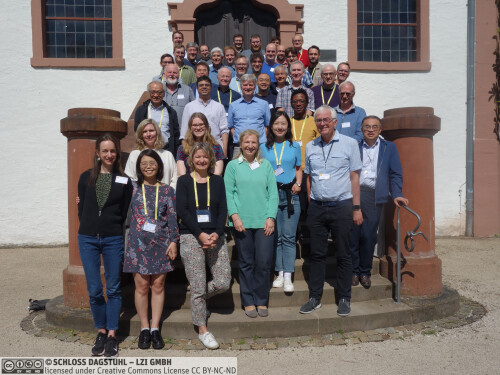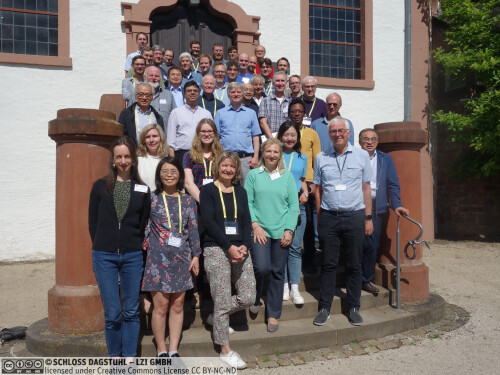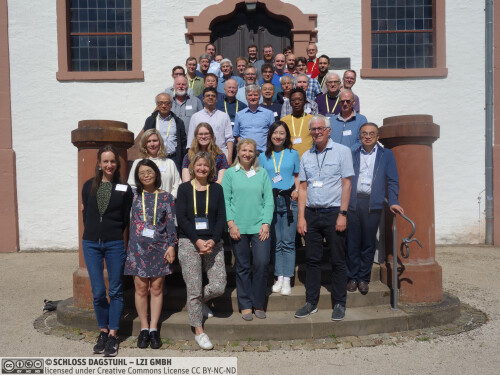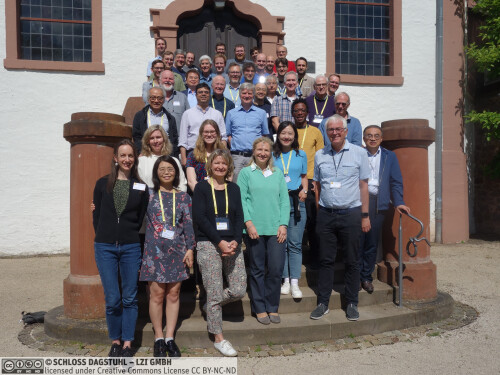Dagstuhl-Seminar 24241
Geometric modeling: Challenges for Additive Manufacturing, Design and Analysis
( 09. Jun – 14. Jun, 2024 )
Permalink
Organisatoren
- Tor Dokken (SINTEF - Oslo, NO)
- Xiaohong Jia (Chinese Academy of Sciences, CN)
- Géraldine Morin (IRIT - University of Toulouse, FR)
- Elissa Ross (Metafold 3D - Toronto, CA)
Kontakt
- Michael Gerke (für wissenschaftliche Fragen)
- Susanne Bach-Bernhard (für administrative Fragen)
Impacts
- Subdivision Algorithms with Modular Arithmetic - Goldman, Ron - Amsterdam : Elsevier, 2024. - 10 pp. - (Computer aided geometric design ; 108. 2024, article 102267).
- Splines for Fast-Contracting Polyhedral Control Nets - Gunpinar, Erkan; Karĉiauskas, Kȩstutis; Peters, Jörg - Amsterdam : Elsevier, 2024. - 11 pp. - (CAD : Computer-Aided Design ; 173. 2024 : article 103727).
Programm
- Professor Chen Falai Receives John A. Gregory Memorial Award, the Highest Honor in the Field of Geometric Design, Wu Yuyang (edited by Jiang Zhimo), University of Science and Technology of China News Center, June 25, 2024.
The Dagstuhl Seminar 24241 "Geometric Modeling: Challenges for Additive Manufacturing, Design and Analysis" took place in the week of June 9–14, 2024. This year, the seminar returned to having on-site participants only. In the previous seminar (2021, during the COVID pandemic), a hybrid format was used. In 2021, close to two thirds of participants joined remotely from eleven different time zones. This year, with all participants on site, all could participate in discussions during breaks, meals, and in the evenings. The popular hike on the afternoon of the third day of the seminar was well-attended, combining scientific discussion with a walk through the beautiful surroundings of Dagstuhl. With most participants joining all five days, we benefited from high attendance during all sessions.
One of the challenges when planning a new Dagstuhl Seminar on geometric modeling was to achieve the right balance between renewal and continuation. This was particularly challenging for this iteration of the seminar, as the targeted number of participants was around 40, in comparison to the more than 50 who attended the 2021 seminar (including both on-site and online participation). Consequently, when making the initial list for invitations, some names that have contributed over many seminars were not included. This was necessary to allow new scientists to be invited in the interest of renewal. As always, there were some late cancellations that allowed us to also invite many of those on the reserve list. Industry participation was higher than in previous events. Many of the participants were newcomers who brought new ideas and life into the discussions. For the next seminar, the organizers will once again have to balance renewal and continuation.
As with previous seminars, geometric modeling remained the core topic of the seminar. However, in recent seminars, the focus has shifted from representation of shape for computer aided design to the challenges posed by a wide use of these technologies in industry and society. In particular, the use of the geometric model is considered within a thorough and complete process in order to design, optimize, and create manufactured 3D content. As the title of the seminar suggests, applications in additive manufacturing, design, and analysis were central. During the seminar, challenges of geometry representation and processing for architecture also arose as a major topic.
The abstracts of the 35 talks presented at the seminar are included in the seminar's full report as well as the conclusions of the three working groups that addressed challenges in:
- geometric modeling for additive manufacturing,
- geometric modeling for design optimization, and
- computer aided geometric design and isogeometric analysis.
The topics discussed in these working groups ranged from theoretical challenges in spline technology, to the need for improved digital technology in geometric modeling, to manufacturing of novel shape concepts in architecture. An emerging theme was the topic of geometric data, which has become more diverse in shape and nature. At the same time, geometric models are also strongly linked and considered in a context broader than the representation of shape, which includes their physical properties and the capabilities to manufacture these models in a sustainable manner. The reflection, work, and opportunities for geometric design and analysis are now more open, and Dagstuhl meetings and the diversity of participants created an opportunity to further this wide vision of the research field.
As always, both the organizers and participants of the Dagstuhl Seminar appreciated the smooth execution of the event, due to the great support and organization from the research center, the great food and lunch meetings, and the opportunity to discuss scientific challenges in a friendly atmosphere at a beautiful location and great venue.
 Tor Dokken, Xiaohong Jia, Géraldine Morin, and Elissa Ross
Tor Dokken, Xiaohong Jia, Géraldine Morin, and Elissa Ross
This Dagstuhl Seminar will focus on the topic of shape and topology representation and optimization, in particular in the context of additive manufacturing (AM), and tackling the generation and use of 3D content for digital twins with controlled accuracy and desired properties at different scales.
Central to the ability to perform design optimization is the ability to capture, process and optimize shapes and topologies, allowing to work on a digital twin for design, or capture with geometry, topology and attached property during manufacturing or later. Topology optimization and the use of lattice structures helps make new designs that better exploit the potential of AM than traditional methods. New modeling tools and techniques are desperately needed to support the specialized needs of geometric modeling in such a computationally intensive and highly automated environment in order to leverage industry 4.0 at scale. We shall also consider the broader context of industry 5.0 aiming at developing sustainable solutions.
CAD based on B-rep targets subtractive manufacturing technologies and assumes that the material properties are isotropic and uniform throughout an object. This is contrary to objects produced by AM, where an object is built layer by layer until the final shape is reached. AM allows variable material combinations, lattice structures and voids but objects will in general exhibit anisotropic material behaviors that are dependent on the actual printing parameter used. Consequently, in AM there is a need for also representing and simulating the interior of an object both at macro, meso and micro scale to support anisotropic properties and complex internal geometric shapes.
Analysis-based design brings performance insights forward into the design phase. This Dagstuhl Seminar will explore recent developments in shape design and simulation for discrete or continuous shapes. In the continuous setting, the combination of the locally refined splines and topology structures for isogeometric analysis (IgA) constitutes a new foundation for CAD-representation, where the interior of volumes is described mathematically (Volume-representation, or V-rep). The seminar will address the interplay of IgA and V-rep and their link to AM. We will also consider some recent approaches using implicit or volumetric models for lattice structures and internal voids, which can provide extremely lightweight representations but may suffer from limitations of accuracy. The seminar will present industrial design challenges occurring from the AM processes, both for smooth shapes and shape with pattern, so that scientific ideas and approaches may emanate.
Decades-old research challenges in merging optimization methods, geometric design methods, and engineering analysis methods remain open, and are increasing in relevance as AM becomes a manufacturing mainstay. This relates not only to assembling multidisciplinary analysis and optimization capabilities, but also in integrating new analysis tools and rapidly adjusting computing tool streams to account for new design challenges. Making effective use of these new modeling algorithms and techniques requires us to continue to advance the state of the art in geometry processing, and data management, analysis, optimization and learning for these large volumes of 3D geometric data.
 Tor Dokken, Xiaohong Jia, Géraldine Morin, and Elissa Ross
Tor Dokken, Xiaohong Jia, Géraldine Morin, and Elissa Ross
- Massimo Carraturo (University of Pavia, IT) [dblp]
- Falai Chen (Univ. of Science & Technology of China - Anhui, CN) [dblp]
- Tor Dokken (SINTEF - Oslo, NO) [dblp]
- Gershon Elber (Technion - Haifa, IL) [dblp]
- Konstantinos Gavriil (SINTEF - Oslo, NO) [dblp]
- Carlotta Giannelli (University of Firenze, IT) [dblp]
- Ron Goldman (Rice University - Houston, US) [dblp]
- Hans Hagen (RPTU Kaiserslautern-Landau, DE) [dblp]
- Stefanie Hahmann (INRIA Grenoble Rhône-Alpes, FR) [dblp]
- Kai Hormann (University of Lugano, CH) [dblp]
- Xiaohong Jia (Chinese Academy of Sciences, CN) [dblp]
- Bert Jüttler (Johannes Kepler Universität Linz, AT) [dblp]
- Panagiotis Kaklis (The University of Strathclyde - Glasgow, GB) [dblp]
- Shahroz Khan (BAR Technologies - Portsmouth, GB) [dblp]
- Myung-Soo Kim (Seoul National University, KR) [dblp]
- Tae-wan Kim (Seoul National University, KR) [dblp]
- Stefan Kollmannsberger (Bauhaus-Universität Weimar, DE) [dblp]
- Jiri Kosinka (University of Groningen, NL) [dblp]
- Tom Lyche (University of Oslo, NO) [dblp]
- Zoë Marschner (Carnegie Mellon University - Pittsburgh, US) [dblp]
- Dominik Mokriš (MTU Aero Engines - München, DE) [dblp]
- Géraldine Morin (IRIT - University of Toulouse, FR) [dblp]
- Caitlin Mueller (MIT - Cambridge, US) [dblp]
- Georg Muntingh (SINTEF - Oslo, NO) [dblp]
- Suraj R. Musuvathy (nTopology - New York, US) [dblp]
- Baldwin Nsonga (Universität Leipzig, DE) [dblp]
- Daniele Panozzo (New York University, US) [dblp]
- Jörg Peters (University of Florida - Gainesville, US) [dblp]
- Jeff Poskin (The Boeing Company - Seattle, US) [dblp]
- Helmut Pottmann (TU Wien, AT) [dblp]
- David Reeves (Metafold 3D - Toronto, CA)
- Ulrich Reif (TU Darmstadt, DE) [dblp]
- Elissa Ross (Metafold 3D - Toronto, CA) [dblp]
- Péter Salvi (Budapest University of Technology and Economics, HU) [dblp]
- Maria Lucia Sampoli (University of Siena, IT) [dblp]
- Espen Sande (EPFL - Lausanne, CH) [dblp]
- Scott Schaefer (Texas A&M University - College Station, US) [dblp]
- Felix Scholz (Johannes Kepler Universität Linz, AT)
- Gunnar Schulze (ttrinckle 3D - Berlin, DE)
- Yongjie Jessica Zhang (Carnegie Mellon University - Pittsburgh, US) [dblp]
- Jianmin Zheng (Nanyang TU - Singapore, SG) [dblp]
- Eric Zimmermann (FU Berlin, DE) [dblp]
Verwandte Seminare
- Dagstuhl-Seminar 9127: Geometric Modelling (1991-07-01 - 1991-07-05) (Details)
- Dagstuhl-Seminar 9326: Geometric Modelling (1993-06-28 - 1993-07-02) (Details)
- Dagstuhl-Seminar 9622: Geometric Modelling (1996-05-27 - 1996-05-31) (Details)
- Dagstuhl-Seminar 99201: Geometric Modelling (1999-05-16 - 1999-05-21) (Details)
- Dagstuhl-Seminar 02201: Geometric Modelling (2002-05-12 - 2002-05-17) (Details)
- Dagstuhl-Seminar 05221: Geometric Modeling (2005-05-29 - 2005-06-03) (Details)
- Dagstuhl-Seminar 08221: Geometric Modeling (2008-05-25 - 2008-05-30) (Details)
- Dagstuhl-Seminar 11211: Geometric Modeling (2011-05-22 - 2011-05-27) (Details)
- Dagstuhl-Seminar 14221: Geometric Modeling (2014-05-25 - 2014-05-30) (Details)
- Dagstuhl-Seminar 17221: Geometric Modelling, Interoperability and New Challenges (2017-05-28 - 2017-06-02) (Details)
- Dagstuhl-Seminar 21471: Geometric Modeling: Interoperability and New Challenges (2021-11-21 - 2021-11-26) (Details)
Klassifikation
- Computational Geometry
- Graphics
- Machine Learning
Schlagworte
- Geometric Modeling
- Additive Manufacturing
- isogeometric analysis
- machine learning





 Creative Commons BY 4.0
Creative Commons BY 4.0
